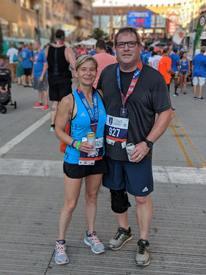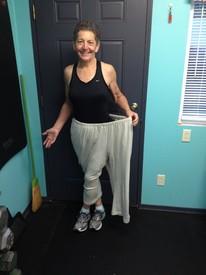Amount of weight vs Reps

theron12
Posts: 60 Member
In order for me to build or maintain muscle does it matter how much weight you lift vs how many reps you can do? For example say someone has a weight bench, curl bar & dumbbells at their home. But they only have 60lbs worth of weight. Could they build/maintain muscle with just that much weight or would you have to eventually lift more weights? Just curious. Explain if you can also. Thanks!
0
Replies
-
I could very well be wrong....
but i think the theory is lift heavier weights at a lower rep to build bulkier muscle and then lighter weights with more reps to build leaner muscle.
Could be wrong. Someone correct me, if so.13 -
chelllsea124 wrote: »I could very well be wrong....
but i think the theory is lift heavier weights at a lower rep to build bulkier muscle and then lighter weights with more reps to build leaner muscle.
Could be wrong. Someone correct me, if so.
There is a hypertrophy zone from about 8 to 12 reps where you maximize muscle growth lifting the weight that will bring you close to failure. Lower reps with more weight will mostly get you stronger and have some hypertrophy. Higher reps with higher weight will give limited hypertrophy and limited strength gains. Mostly improvement in muscle tone.1 -
chelllsea124 wrote: »I could very well be wrong....
but i think the theory is lift heavier weights at a lower rep to build bulkier muscle and then lighter weights with more reps to build leaner muscle.
Could be wrong. Someone correct me, if so.
All muscle is lean. There is no "bulky" muscle.9 -
chelllsea124 wrote: »I could very well be wrong....
but i think the theory is lift heavier weights at a lower rep to build bulkier muscle and then lighter weights with more reps to build leaner muscle.
Could be wrong. Someone correct me, if so.
There is a hypertrophy zone from about 8 to 12 reps where you maximize muscle growth lifting the weight that will bring you close to failure. Lower reps with more weight will mostly get you stronger and have some hypertrophy. Higher reps with higher weight will give limited hypertrophy and limited strength gains. Mostly improvement in muscle tone.
I attempted for a while just to get some extra muscle tone and then everyone kept telling me that what I was doing was wrong so I got so frustrated, that I stopped. I wasn't lifting super heavy weights. I was lifting enough to challenge me and doing 3 sets of like 12 or 15.0 -
The concept in general is Progressive Overload. As long as you're constantly challenging yourself, which you can do with isolation exercises, higher reps, supersets...you're going to improve.
I mean, look at people who only do Bodyweight exercises. You can build and maintain muscle with almost no tools, it just depends on your goals. 3
3 -
chelllsea124 wrote: »chelllsea124 wrote: »I could very well be wrong....
but i think the theory is lift heavier weights at a lower rep to build bulkier muscle and then lighter weights with more reps to build leaner muscle.
Could be wrong. Someone correct me, if so.
There is a hypertrophy zone from about 8 to 12 reps where you maximize muscle growth lifting the weight that will bring you close to failure. Lower reps with more weight will mostly get you stronger and have some hypertrophy. Higher reps with higher weight will give limited hypertrophy and limited strength gains. Mostly improvement in muscle tone.
I attempted for a while just to get some extra muscle tone and then everyone kept telling me that what I was doing was wrong so I got so frustrated, that I stopped. I wasn't lifting super heavy weights. I was lifting enough to challenge me and doing 3 sets of like 12 or 15.
An approach that I've seen used successfully for muscle growth is to use the most weight that you can use for 8 reps and 3 sets. Use that until you can do 12 reps with that weight, then add. And so on, and soon. Of course you have to have the right dietary conditions to add muscle mass. Eg. eating at maintenance or above, or be a newbie, returner or obese.2 -
elizabethmcopeland wrote: »The concept in general is Progressive Overload. As long as you're constantly challenging yourself, which you can do with isolation exercises, supersets...you're going to improve.
I mean, look at people who only do Bodyweight exercises. You can build and maintain muscle with almost no tools, it just depends on your goals.
You can. I am not a fan of either iso or supersetting. The former because it takes too much time and I like full body compounds. The later because I think you take energy and focus away from good lifting technique. If I'm looking to build (or keep) muscle, that is what I'm going to focus in. YMMV0 -
You can stop increasing the weight and will maintain what you've got.
If you just keep increasing the reps to keep making it difficult - you'll start using slightly different muscle type. So now that type is difficulty and it starts getting stronger.
For instance take 60lbs max and doing like squats - you could get to point that you could do 100 in a row.
That is a different muscle type that is being work compared to say 5 reps feeling as hard with more weight.
But if you kept doing 100 squats with 60 lbs - you'd likely be surprised that you could not move down to say 5 reps with 200 lbs at some point - just different muscles that stopped getting worked as well when the reps kept going up.
So still a good workout, can keep maintenance. Just depends on purpose and desires.
3 x 12-15 is just great and has been shown in studies up to 20 reps even can give good hypertrophy.
And yeah, no such thing as lean muscles like you could cause it beyond genetics by a certain lifting style. About the only way to add more fat is endurance cardio.
Otherwise lean muscle is what you order at the butcher.1 -
You'll get a ton of Bro-science from posts on here.. But:
Diet.
A good, proven program. And Good lifting technique. Both are equal and essential.
Diet.
Progressive overload. - So enough weight to be challenging. Repeat until it's not. Add more weight, repeat.
Diet.
Consistency - The only bad session is the one you don't turn up for.
Diet.
No such thing as Bulky\Lean Muscle. Muscle is Muscle. It grows at x rate\point regardless.
Rep numbers kinda count - low reps are more strength orientated. Higher is preferred for building muscle.
Without knowing your training experience, I'd not state rep ranges\sets etc. If your knew, just do what the basic starting programs tell you.
The real key is Diet. Dunno if i mentioned that?
I'm a big fan of K.I.S.S - Keep It Simple Stupid - From A article i read on a powerlifting site but the points can be taken to many other areas - Basically If your not a qualified PT, with 10+ years experience, then just stick the the basics.
I've lifted for 8 years, and still tell myself that ^^
Oh. and above the rest - Diet.
2 -
chelllsea124 wrote: »I could very well be wrong....
but i think the theory is lift heavier weights at a lower rep to build bulkier muscle and then lighter weights with more reps to build leaner muscle.
Could be wrong. Someone correct me, if so.
There is a hypertrophy zone from about 8 to 12 reps where you maximize muscle growth lifting the weight that will bring you close to failure. Lower reps with more weight will mostly get you stronger and have some hypertrophy. Higher reps with higher weight will give limited hypertrophy and limited strength gains. Mostly improvement in muscle tone.
if you wanna build muscle, lift in the hypertrophy zone (and eat) Once you max out your 60 lbs of weight at home, you will level off and maybe even lose some muscle size as your body gets efficient. If you are serious about bodybuilding, just get on a lifting program that tells you exactly how many reps and sets to do and what to eat.0 -
Thanks for the input everyone!1
-
singingflutelady wrote: »chelllsea124 wrote: »I could very well be wrong....
but i think the theory is lift heavier weights at a lower rep to build bulkier muscle and then lighter weights with more reps to build leaner muscle.
Could be wrong. Someone correct me, if so.
All muscle is lean. There is no "bulky" muscle.
This is information I got from like 4 different people. So I'm not the idiot. They are.
 3
3 -
chelllsea124 wrote: »singingflutelady wrote: »chelllsea124 wrote: »I could very well be wrong....
but i think the theory is lift heavier weights at a lower rep to build bulkier muscle and then lighter weights with more reps to build leaner muscle.
Could be wrong. Someone correct me, if so.
All muscle is lean. There is no "bulky" muscle.
This is information I got from like 4 different people. So I'm not the idiot. They are.

be careful who and where you get your info from 0
0 -
chelllsea124 wrote: »singingflutelady wrote: »chelllsea124 wrote: »I could very well be wrong....
but i think the theory is lift heavier weights at a lower rep to build bulkier muscle and then lighter weights with more reps to build leaner muscle.
Could be wrong. Someone correct me, if so.
All muscle is lean. There is no "bulky" muscle.
This is information I got from like 4 different people. So I'm not the idiot. They are.

be careful who and where you get your info from
But I want to lose fat in just my butt.... how do I do that?! lmao2 -
There are a few really good guidelines.
Specificity is the most important. Work the muscles you want to build, seems obvious, but if you only have 60 lbs, you may have to do more isolation because with isolation, you use less weight.
Always lift at 60% 1RM or greater, don't bother lifting more than 90-95% 1RM
If you are within the first 2 years of lifting, complete the amount of reps with that weight that will take you to within 3-5 reps of failure. We're talking failure of form, not muscle failure.
If you are more experienced, go to within 0-3 reps of failure.
Muscle benefits from a variety of reps ranges from 3-20 or so. Lower reps get you strength, higher reps get you hypertrophy, but you must lift with weights that correspond to the rep range, heavier for low reps, lighter for high reps to within that range of failure above.
3-5 sets are good, any more than 5 and you get diminishing or negative returns.
Reps per week
Large muscle groups 60-120 reps
Smaller muscle groups 30-60 reps
Here's a couple fancy graphics.

One more thing. No muscle without a calorie surplus. yeah yeah recomp, but it's not ideal.
5 -
singingflutelady wrote: »chelllsea124 wrote: »I could very well be wrong....
but i think the theory is lift heavier weights at a lower rep to build bulkier muscle and then lighter weights with more reps to build leaner muscle.
Could be wrong. Someone correct me, if so.
All muscle is lean. There is no "bulky" muscle.
bulky might not be a term some people use, When it comes to strong muscles, there are big muscles and small muscles and all sizes in between, all are strong for their own purpose. The general rule is heavy low rep is for strength, med rep (8-12) is for hypertrophy (sometimes called bulky) and high rep for endurance (less size sometimes referred to as lean)1 -
singingflutelady wrote: »chelllsea124 wrote: »I could very well be wrong....
but i think the theory is lift heavier weights at a lower rep to build bulkier muscle and then lighter weights with more reps to build leaner muscle.
Could be wrong. Someone correct me, if so.
All muscle is lean. There is no "bulky" muscle.
Idk, man. some of these dudes in the gym are definitely looking bulky!!! 3
3 -
There are a few really good guidelines.
Specificity is the most important. Work the muscles you want to build, seems obvious, but if you only have 60 lbs, you may have to do more isolation because with isolation, you use less weight.
Always lift at 60% 1RM or greater, don't bother lifting more than 90-95% 1RM
If you are within the first 2 years of lifting, complete the amount of reps with that weight that will take you to within 3-5 reps of failure. We're talking failure of form, not muscle failure.
If you are more experienced, go to within 0-3 reps of failure.
Muscle benefits from a variety of reps ranges from 3-20 or so. Lower reps get you strength, higher reps get you hypertrophy, but you must lift with weights that correspond to the rep range, heavier for low reps, lighter for high reps to within that range of failure above.
3-5 sets are good, any more than 5 and you get diminishing or negative returns.
Reps per week
Large muscle groups 60-120 reps
Smaller muscle groups 30-60 reps
Here's a couple fancy graphics.

One more thing. No muscle without a calorie surplus. yeah yeah recomp, but it's not ideal.
This is interesting. Not to hijack OPs thread, but I have a question about "training for power". I feel like I am reasonably strong for my size, but I think I might be lacking power. For example, recently while doing P90X3, I noticed that I have a hard time with the plyometric type exercises. I can't jump high at all and, even though I have good cardio endurance, these drills wear me out fast. This is the case for any exercise that requires a "springy" type movement (for lack of knowing the proper term). I was thinking it is because my muscles lack flexibility. Is this what is meant by "training for power"? Is high reps with low weight a good way to improve this?0 -
lporter229 wrote: »There are a few really good guidelines.
Specificity is the most important. Work the muscles you want to build, seems obvious, but if you only have 60 lbs, you may have to do more isolation because with isolation, you use less weight.
Always lift at 60% 1RM or greater, don't bother lifting more than 90-95% 1RM
If you are within the first 2 years of lifting, complete the amount of reps with that weight that will take you to within 3-5 reps of failure. We're talking failure of form, not muscle failure.
If you are more experienced, go to within 0-3 reps of failure.
Muscle benefits from a variety of reps ranges from 3-20 or so. Lower reps get you strength, higher reps get you hypertrophy, but you must lift with weights that correspond to the rep range, heavier for low reps, lighter for high reps to within that range of failure above.
3-5 sets are good, any more than 5 and you get diminishing or negative returns.
Reps per week
Large muscle groups 60-120 reps
Smaller muscle groups 30-60 reps
Here's a couple fancy graphics.

One more thing. No muscle without a calorie surplus. yeah yeah recomp, but it's not ideal.
This is interesting. Not to hijack OPs thread, but I have a question about "training for power". I feel like I am reasonably strong for my size, but I think I might be lacking power. For example, recently while doing P90X3, I noticed that I have a hard time with the plyometric type exercises. I can't jump high at all and, even though I have good cardio endurance, these drills wear me out fast. This is the case for any exercise that requires a "springy" type movement (for lack of knowing the proper term). I was thinking it is because my muscles lack flexibility. Is this what is meant by "training for power"? Is high reps with low weight a good way to improve this?
No, high reps with a low weight would not train power. Typically you would use a moderately heavy weight for low reps with a quick movement. For example, I do power cleans for 3 reps x 5 sets. The movement has to be done explosively or I wouldn't be able to rack the bar on my shoulders.0 -
chelllsea124 wrote: »singingflutelady wrote: »chelllsea124 wrote: »I could very well be wrong....
but i think the theory is lift heavier weights at a lower rep to build bulkier muscle and then lighter weights with more reps to build leaner muscle.
Could be wrong. Someone correct me, if so.
All muscle is lean. There is no "bulky" muscle.
Idk, man. some of these dudes in the gym are definitely looking bulky!!!
A five pound bag loaded with six pounds of sand would look bulky. A five pound bag loaded with two pounds of sand would look slender.
But they're both filled with sand.
The difference between "lean" muscle and "bulky" muscle is how much of it there is.3 -
chelllsea124 wrote: »singingflutelady wrote: »chelllsea124 wrote: »I could very well be wrong....
but i think the theory is lift heavier weights at a lower rep to build bulkier muscle and then lighter weights with more reps to build leaner muscle.
Could be wrong. Someone correct me, if so.
All muscle is lean. There is no "bulky" muscle.
Idk, man. some of these dudes in the gym are definitely looking bulky!!!
A five pound bag loaded with six pounds of sand would look bulky. A five pound bag loaded with two pounds of sand would look slender.
But they're both filled with sand.
The difference between "lean" muscle and "bulky" muscle is how much of it there is.
It was a joke.2 -
ijsantos2005 wrote: »lporter229 wrote: »There are a few really good guidelines.
Specificity is the most important. Work the muscles you want to build, seems obvious, but if you only have 60 lbs, you may have to do more isolation because with isolation, you use less weight.
Always lift at 60% 1RM or greater, don't bother lifting more than 90-95% 1RM
If you are within the first 2 years of lifting, complete the amount of reps with that weight that will take you to within 3-5 reps of failure. We're talking failure of form, not muscle failure.
If you are more experienced, go to within 0-3 reps of failure.
Muscle benefits from a variety of reps ranges from 3-20 or so. Lower reps get you strength, higher reps get you hypertrophy, but you must lift with weights that correspond to the rep range, heavier for low reps, lighter for high reps to within that range of failure above.
3-5 sets are good, any more than 5 and you get diminishing or negative returns.
Reps per week
Large muscle groups 60-120 reps
Smaller muscle groups 30-60 reps
Here's a couple fancy graphics.

One more thing. No muscle without a calorie surplus. yeah yeah recomp, but it's not ideal.
This is interesting. Not to hijack OPs thread, but I have a question about "training for power". I feel like I am reasonably strong for my size, but I think I might be lacking power. For example, recently while doing P90X3, I noticed that I have a hard time with the plyometric type exercises. I can't jump high at all and, even though I have good cardio endurance, these drills wear me out fast. This is the case for any exercise that requires a "springy" type movement (for lack of knowing the proper term). I was thinking it is because my muscles lack flexibility. Is this what is meant by "training for power"? Is high reps with low weight a good way to improve this?
No, high reps with a low weight would not train power. Typically you would use a moderately heavy weight for low reps with a quick movement. For example, I do power cleans for 3 reps x 5 sets. The movement has to be done explosively or I wouldn't be able to rack the bar on my shoulders.
I was struggling to answer this one. At first I thought "explosiveness" was what she was thinking, but I'm guessing that it's actually strength because the complaint is that the drills are wearing her out fast and if she had more leg strength it might fix that. I take it for granted that cardiovascular endurance is already there. I think that if she were to gain strength in a similar type of movement (squats, weighted lunges or hack squats) that would help with the endurance part. Another thing to think about is perhaps she isn't eating enough carbs to fuel a longer workout like that.0 -
elizabethmcopeland wrote: »The concept in general is Progressive Overload. As long as you're constantly challenging yourself, which you can do with isolation exercises, higher reps, supersets...you're going to improve.
I mean, look at people who only do Bodyweight exercises. You can build and maintain muscle with almost no tools, it just depends on your goals.
Very true.0 -
There has been some recent research to suggest that lifting with lighter weights can result in more hypertrophy results than previously thought. The practical applications will take time to sort out (as well as more research needed), but the idea is interesting.
https://www.t-nation.com/training/light-weights-for-big-gains
2 -
There has been some recent research to suggest that lifting with lighter weights can result in more hypertrophy results than previously thought. The practical applications will take time to sort out (as well as more research needed), but the idea is interesting.
https://www.t-nation.com/training/light-weights-for-big-gains
Great article about this topic by Greg Nuckols here: https://www.strongerbyscience.com/hypertrophy-range-fact-fiction/
The article includes this graphic for rep ranges, regarding what people think happens vs. what really happens:
6 -
I have seen and used the chart above to plan my personal program and stay w/in the upper left portion of the chart for max strength and size development.
I currently vary my workouts in terms of sets/reps between 3x10, 4x6 and 5x5. If it's not obvious, the weight lifted is higher w/low reps and lower w/high reps. I also pyramid my sets starting around 60% up to around 105% of my calculated 1RM for each lift.
I go over 100% when trying to increase strength; if I succeed, it becomes my the new 100% 1RM level. If I don't, I just go back to my old 1RM until I want to try to increase it again. I don't do "drop" sets; don't believe in them.
If you can already lift a specific weight, why go lower than that, as long as you are getting sufficient rest between lifting efforts? Understand why they are suggested but drop sets just seem defeatist to me. Just my POV.
I used my calculated 1RM based on the highest rep/weight combo to measure my progress. It doesn't matter whether I can actually lift the calculated 1RM or not; often I cannot.
It's just a way to increase the weights progressively and to measure and compare my progress consistently, when using different weight/rep schemes.
If your calculated 1RM for a lift is increasing, you are getting stronger regardless of which weight scheme you are using.
Doesn't matter which lift calculator you use; they all differ in how they arrive at the calculation. Just make sure to use the SAME calculator consistently or your results will not be comparable.
BTW, few people actually know what their actual 1RM level for a lift is because they never attempt it and if they do they are not happy w/the result because it is much lower than what they expected.
Unless you're a power lifter, your 1RM is really of NO importance, it only matters that you are making progress in your lifting my getting stronger, which is why I only use my calculated 1RM to measure my progress.
It is also wise to avoid trying to actually do a 1RM lift, especially if you can actually lift really heavy (relative to your body weight) because the risk of injury is so much higher.
For example, I'm 66 and weigh only 158# but my highest calculated 1RM for the DL is currently 395 (5x340). This is a very low number in the scheme of things but is a very high number for my weight and age.
I actually tried pulling 395 one day and am not embarrassed to say that I couldn't even budge it. I also tried pulling 360 (when I was doing only 5x310) and actually got light headed and nearly fainted. However, I am lifting about 10% more now than I was then w/o negative effects.
So, I don't try to do an actual 1RM anymore. Just not necessary and potentially dangerous; at least to me.2 -
The Bottom line is that depending on your rep/lift scheme, you can get
Stronger faster than you get bigger
bigger faster than you get stronger
Bigger and stronger at about the same pace
That big man in the corner doing curls and grunting is not necessarily stronger than that "little" woman doing squats.0 -
As a post menopausal and completely unfit sedentary woman with diabetes, lupus, and a recent abdominal surgery, I outgrew 60 lbs in about a month. After about four months I'm about to outgrow 120lbs which is the max which will fit on my crappy starter set - I need a real bar and real weights now. And that's me, basically the least fit person possible without actually being in a hospital. There are certainly exercises you can do with 60lbs, or even bodyweight, but if you want to do progressive lifting you are quickly going to want more.2
-
rheddmobile wrote: »As a post menopausal and completely unfit sedentary woman with diabetes, lupus, and a recent abdominal surgery, I outgrew 60 lbs in about a month. After about four months I'm about to outgrow 120lbs which is the max which will fit on my crappy starter set - I need a real bar and real weights now. And that's me, basically the least fit person possible without actually being in a hospital. There are certainly exercises you can do with 60lbs, or even bodyweight, but if you want to do progressive lifting you are quickly going to want more.
Great job!1 -
lporter229 wrote: »There are a few really good guidelines.
Specificity is the most important. Work the muscles you want to build, seems obvious, but if you only have 60 lbs, you may have to do more isolation because with isolation, you use less weight.
Always lift at 60% 1RM or greater, don't bother lifting more than 90-95% 1RM
If you are within the first 2 years of lifting, complete the amount of reps with that weight that will take you to within 3-5 reps of failure. We're talking failure of form, not muscle failure.
If you are more experienced, go to within 0-3 reps of failure.
Muscle benefits from a variety of reps ranges from 3-20 or so. Lower reps get you strength, higher reps get you hypertrophy, but you must lift with weights that correspond to the rep range, heavier for low reps, lighter for high reps to within that range of failure above.
3-5 sets are good, any more than 5 and you get diminishing or negative returns.
Reps per week
Large muscle groups 60-120 reps
Smaller muscle groups 30-60 reps
Here's a couple fancy graphics.

One more thing. No muscle without a calorie surplus. yeah yeah recomp, but it's not ideal.
This is interesting. Not to hijack OPs thread, but I have a question about "training for power". I feel like I am reasonably strong for my size, but I think I might be lacking power. For example, recently while doing P90X3, I noticed that I have a hard time with the plyometric type exercises. I can't jump high at all and, even though I have good cardio endurance, these drills wear me out fast. This is the case for any exercise that requires a "springy" type movement (for lack of knowing the proper term). I was thinking it is because my muscles lack flexibility. Is this what is meant by "training for power"? Is high reps with low weight a good way to improve this?
Power is the ability to apply strength quickly. You can be strong, but not as powerful as someone who may not have the as much pure strength as you. That comes down to genetics a lot of times, but can be trained to maximize your potential. To train for power, you will want to do explosive movements. Jumps, throws, Olympic movements, plyometrics. They are very taxing movements which is why you wear out quickly, and possibly an indicator your cardio system might not be as developed as u think.0
This discussion has been closed.
Categories
- All Categories
- 1.4M Health, Wellness and Goals
- 398.5K Introduce Yourself
- 44.7K Getting Started
- 261K Health and Weight Loss
- 176.4K Food and Nutrition
- 47.7K Recipes
- 233K Fitness and Exercise
- 462 Sleep, Mindfulness and Overall Wellness
- 6.5K Goal: Maintaining Weight
- 8.7K Goal: Gaining Weight and Body Building
- 153.5K Motivation and Support
- 8.4K Challenges
- 1.4K Debate Club
- 96.5K Chit-Chat
- 2.6K Fun and Games
- 4.8K MyFitnessPal Information
- 18 News and Announcements
- 21 MyFitnessPal Academy
- 1.5K Feature Suggestions and Ideas
- 3.2K MyFitnessPal Tech Support Questions
















